This post may contain some affiliate links
Thanks so much Jonny for taking the time to do this interview.
First of all, tell me a little about your background and how you got started painting.
Hi, my name is Jonny Nelson. I was born in Northern Ireland in the UK and had a normal upbringing for the 80’s in rural Ireland. It rained a lot and so, although I got outside whenever I could, there was a lot of inside time to get creative.
I was more a maker than an artist though – I tried all sorts of crafts from making paper cars and farm equipment, to wood carving to making sculptures out of junk.
Pyrography, painting by numbers right through to painting my entire bedroom black and covering the walls with homemade satirical and whimsical pieces that I thought were so deep and meaningful at the time.
I wasn’t particularly good at art in school, getting a B in my GCSE art and design class, but I just like making things and it didn’t matter if it graded well or not.
After University (Mechanical Engineering) I moved to England for my first Job designing Aero Engines. I took up a new craft – wood turning – and absolutely love the shapes and forms you can make on the lathe.
Some of my Favorite ever creations came from this source, like this bowl in Yew.
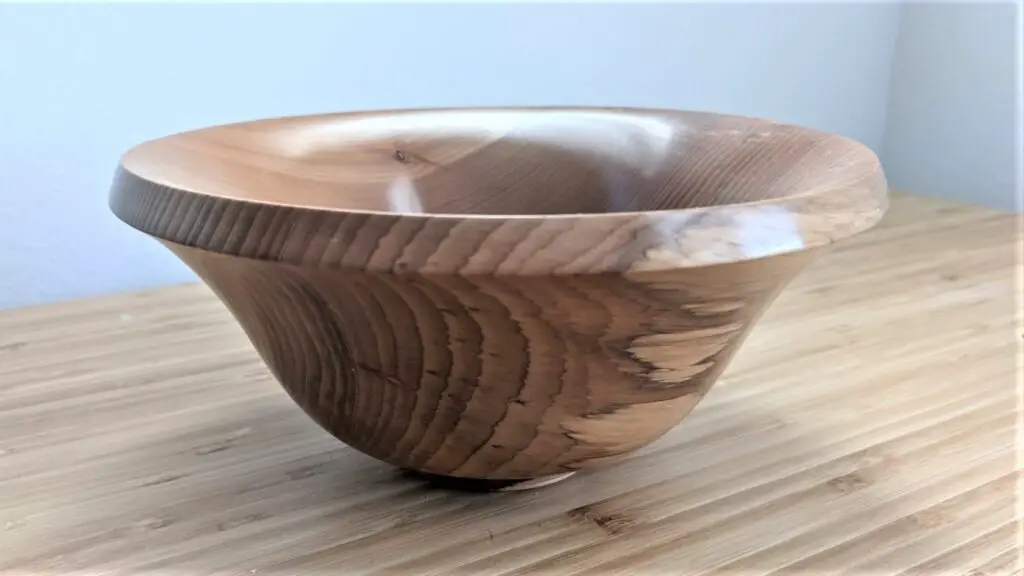
– Simple Continuous lines, chunky feel, it’s almost as much about how it feels as how it looks. I liked that you could just keep working at it until you liked it.
I started embossing copper at this time too and I turned some platters and fixed Celtic patterns into the center of them. These looked cool and I still have some of them – like this one.
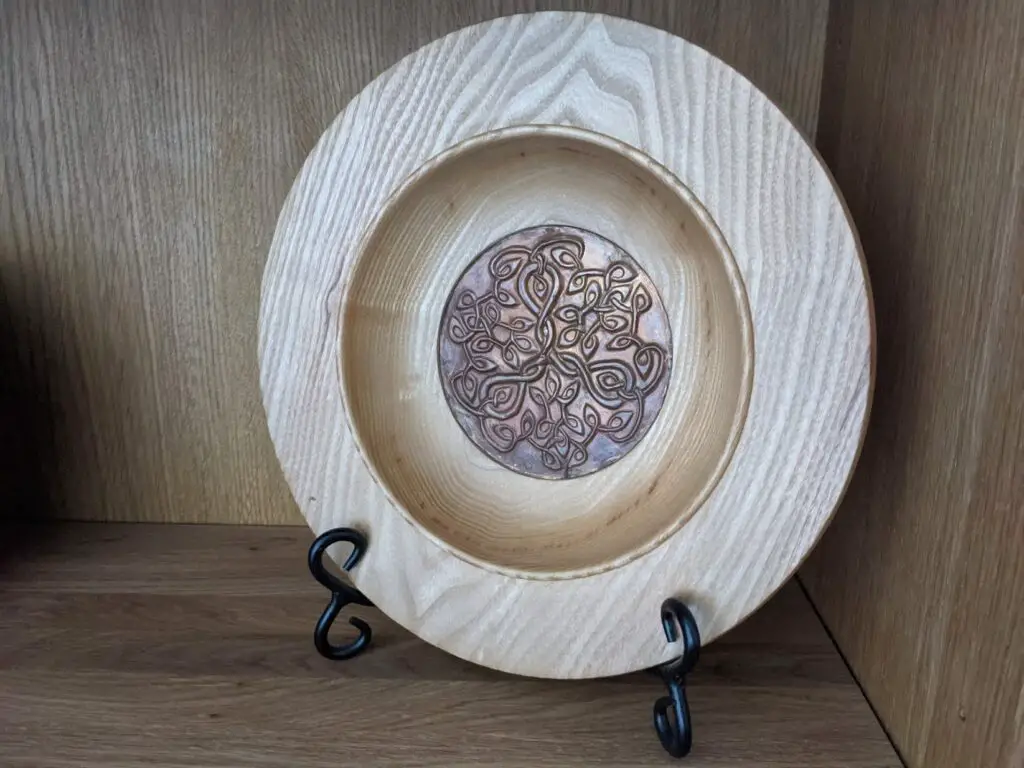
My Art Journey has been more of an evolution rather than a singular addiction.
I’m always looking for the next step, that something new that I’ve not seen before but evolves out of what I was working on last.
In that vein let’s skip forwards 10 years and I find myself living in Inverness in Scotland working in Medical devices. My creative outlet has evolved into Jewelry making and I’m making more simple forms like this flower in Sterling silver and gold.

And so it continued… I keep what I know and try to add something new. I tried to combine my love of wood and new found jewelry skills. I try my hand at enameling, cloisonne and champleve with a little success, but its hard work and slow and doesn’t really lend itself to a lot of experimentation.
You need to do a lot of the same thing to get really good at intricate enamel jewelry and my head was always wandering off to the next thing.
Jump forward another 6 or 7 years and I have 2 almost teen-age daughters and I’ve just moved from Pennsylvania to Southern California for work.
My youngest has inherited the Arts and craft bug and has seen an acrylic pouring video on YouTube that she wants to try. We jump in together, pouring every weekend and trying to replicate all of the cool techniques that are popular at that time.
2 years later, she has moved on, but I’m still hooked.
What is your creative process like?
All my ideas start off in my head, usually with a quick burst of inspiration, not normally a finished piece, but usually a method or a pattern.
Then there are 2 paths – 1. I have to go and execute the idea there and then. Or 2. I think about it over a couple of days in the back of my head until I get it all fleshed out.
For instance just now I’m wondering how creased aluminum foil would look under transparent colored resin. Its not a finished idea or picture, more of a texture idea that probably needs some other theme or feature to make it work.
I’ll just let it sit in my head and grow into something for now.
For my more complex pieces there is usually some prep work to do, modelling a pattern or bending wires to shape or whatever.
I tend to do these steps in chunks over a few days as they are forgiving and adjustable and I know that when I come to add the color it is the opposite and I only get one shot.
I will tweak these and take a break from them occasionally so that I can be sure I’m happy with them before I go near any resin or paint. When it comes time to add the color I like to have everything prepped and ready to go – I shouldn’t need to move to finish the piece.
I have to fight myself often not to add additional colors in the middle of a piece and stick to the plan. This phase is fairly intense, but also very meditative as my sole focus is on the piece and the rest of life is put on hold for a couple of hours.
What’s your work space setup like?
My workspace is small and cluttered. No matter how much space I make myself on a tidy up day, everything tends to migrate back in to the area immediately next to the canvas or board that I’m working on.
The set up is primarily arranged around my video equipment. The cameras are always pointed at roughly the same spot and so that’s where the workpiece will go.
I shoot against a black background and so the table I use is always covered in a black sheet and I have a black board on my right for the low angle camera background.
That board hides most of my daily use tools from my dotting tools, to a box cutter and scissors, ruler, tweezers, brushes, spirit level… etc etc.
On the table, to the back and left of the work area is where I keep all my daily use paints, premixed in squeezy bottle usually, but also in little tubs.
Behind my table I have a shelf with all my unmixed paint storage and then the rest of the space around the table is filled with canvases, boards, resin, floetrol, all manner of house paints, other boxes of paints, cups, alcohol inks – frankly its an embarrassing mess.
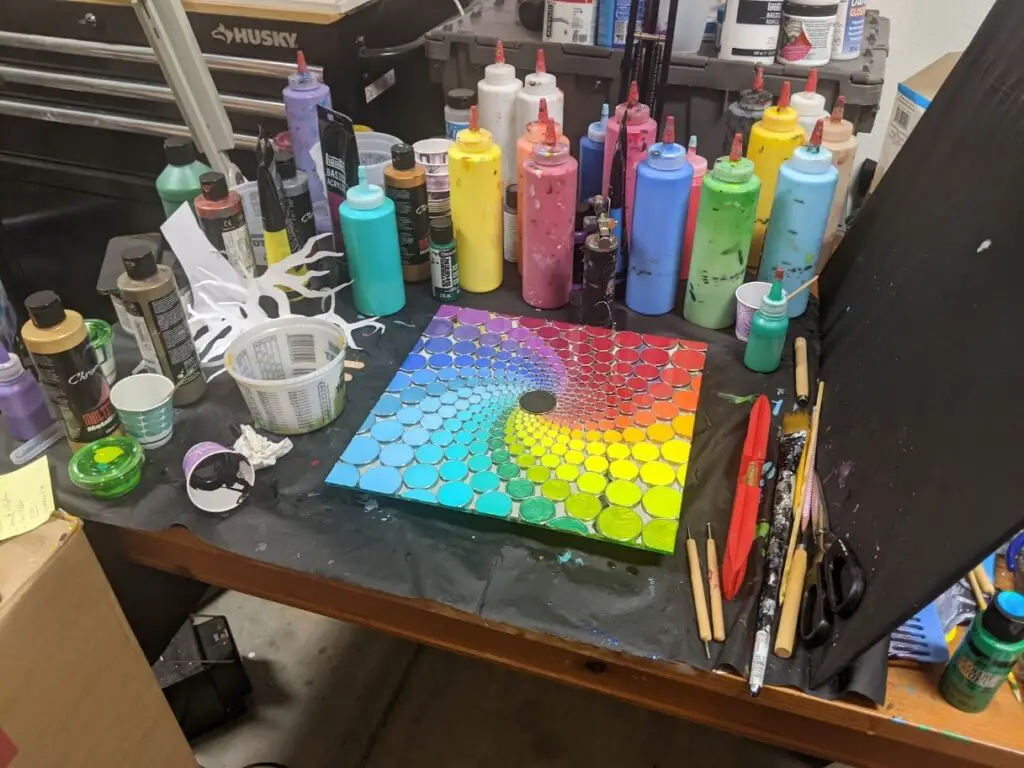
What’s your best time-saving painting shortcut or hack?
My Hack? Move to painting on Aluminum composite panels instead of canvases.
First they are flat and stiff and so easy for sticking wire forms down onto. You can weigh them down without everything moving. Then with resin (and paint) the sharp edges mean there is less tendency for run off.
It just stays on top where you put it. Within reason obviously… Then there is the reflective quality especially with transparent resins. The light bounces through and they shine.
They stack easily and lastly, if you mess up, you can normally peel the resin off when cured or if you are using paint just throw the whole panel in the sink and scrub it off and start over.
What inspires your creativity?
I usually have several ideas buzzing around or in the works. Inspiration literally comes from anywhere and everywhere. If I see something on Facebook that I like the look of I just take a screen shot of it so I can come back to it later.
It might not be another piece of art, it may be a texture or a pattern on a fence or a glass sculpture or literally anything, and I usually start off with an ooh… I wonder… and then it develops over time.
A great example of this is one of my favorite resin pieces. I saw a photo of some wallpaper and it had these simple thin lines snaking across the surface. I modelled something similar and created this piece of wall art in resin…
This piece is on a shiny aluminum composite panel and the colored ribbons are in transparent resin while the background is in opaque resin. The contrast between these 2 things is what brings this piece to life and give it depth.

Just finding this photo and looking at it again inspires me to do another one, a bit bigger maybe. And that is the other source of my inspiration.
While I’m making a piece I very often want to do a slight variation of it (I never make the same thing twice), and this leads to a constant evolution of my look.
If you take the time to look through all my YouTube videos you will see this progression – I’m almost inspired to make a video on that…
Besides painting, are there other forms of art that you like to do?
Think I’ve covered this one…
One thing, I have noticed it’s the beautiful color palettes that you use to create your artwork. How do you decide on what colors will compliment and provide a mesmerizing design for your artwork? How many colors are too many?
Yeah this is a great question. I really struggle with this aspect of pouring as I’m forever buying new colors and wanting to just keep adding more to a pour, quite often to its detriment.
I think optimum number of colors is 4 or so. As usual there are a few rules of thumb and I use a color wheel just like all other artists. Pouring can be quite unforgiving if you get your color choice wrong and it’s much more prone to making muddy colors if you do.
The flip side is that if I choose well, the colors blend together and can make something more intricate in pattern and in color range than I could ever do with a pot of paint and a brush.
It always surprises me – For example, this is one of my favorite pours and a type of pour that I invented where you use wires to guide a series or ripple pours. It is abstract, but you have to create this by rippling paint between wires – trying to do this with a brush just wouldn’t make sense, nor would it work.

So how do I find combinations that work? I just try it and see what happens – I use colors that I think will work well together, throw in a strong contrasting color (really important for pouring) and separate any colors that won’t mix well together with a little black or white.
That’s usually enough to keep them apart. Sometimes it works out. Sometimes it doesn’t. Sometimes I don’t like it and post it anyway only to find that everyone loves it, sometimes the reverse happens.
There is no right or wrong color choice, but with online art, it’s definitely best to find colors that your audience likes, even if you don’t. The only way to find that out is to post some videos.
Can you give beginner painters some beginner tips for starting out online?
Tip 1 – If you want to be successful on YouTube specifically, you really have to niche down. I do both resin and acrylic art and even that is too much variation, and it hurts my views. Pick a niche and stick to it.
Tip 2 – Content is king. Good content will get you good views and subscribers, don’t be tempted to post poor work just because you haven’t posted in a couple of days. It’s a real turn off for viewers.
Tip 3 – Thumbnails and descriptions need a lot of work. These are the 2 things that people see to make them decide to click the video. They are literally more important than the video. Don’t show a finished piece in the thumbnail unless it’s a brand new look. You have to tease the viewer with just enough info to intrigue them. Showing the finished piece is like showing them the punchline to a joke before you start telling it.
Tip 4 – Starting out, find a Facebook group that allows you to share video links and do just that. There are thousands of potential subscribers on FB and the groups are great for driving viewers to your channel.
Tip 5 – Don’t be tempted to do any sub for sub. In fact, block anyone who asks for that. You need all your subscribers to actually be interested in your videos.
Tip 6 – Be regular, be concise, be lucky and a million other things…
What are the best paints to use?
You know, there are so many brands of paint out there that it’s not for me to say which is best. What I would say is that all brands and types of paint have different qualities and it takes time to get to know how they will behave, especially when it comes to pouring.
I have paints I just don’t use because the pigments bleed. I have metallics that work well with regular acrylics and those that don’t. Different paint densities can create cool effects, but if you are not wanting these effects it can ruin a piece.
Some pigments blend well to give nice color gradients, others turn to mud if they come within 10 feet of each other. This is true for both paint and resin pigments. Add in paint transparency and the matting effect of floetrol and it can be quite daunting to try to analyze what will work and what wont.
In short I recommend you buy what looks good to you, Liquitex Basics is a good place to start, but always try out your palate before putting on the canvas. Learn how they work together and adjust as required.
One final tip though – Avoid cheap craft paints, especially cheap white paint. These have lots of filler (clay) in them and when they dry they can be quite brittle and cause cracking.
What’s the best paint consistency for pouring?
This totally depends on the type or pouring you are doing. Lots of people say it should be like warm honey, but I always wonder if they have ever seen warm honey. I mean who heats their honey up?
For my wire pours and for ring pours you actually want the paint to be quite thick, for flip cups and straight pours and all those basic techniques you want it to flow, so like the consistency of the premixed pouring paints you can buy. For air swipes (often called Dutch pours) you want it to be even less viscous.
Again, see what works for you and don’t necessarily follow the crowd. What I would say as a rule – all techniques work best if all the paints used on the day are the same consistency.
Where can people find your artwork?
I don’t actually sell my work at the minute. I just create things for me and I get all the recognition I need when someone likes one of my videos or leaves a nice comment.
I have of course given some pieces away as gifts and others to charity, but mostly they end up on the walls of my house. There are plans in the works to change this though, as I keep getting asked for my templates.
Soon I hope to start selling at least those online in the US.
Where are all the places people can follow you online?
Primarily I can be found on YouTube
I’m also on Facebook
Can you give some examples of your favorite creations?
Sure – Here are just a few random examples of pieces that I really like.
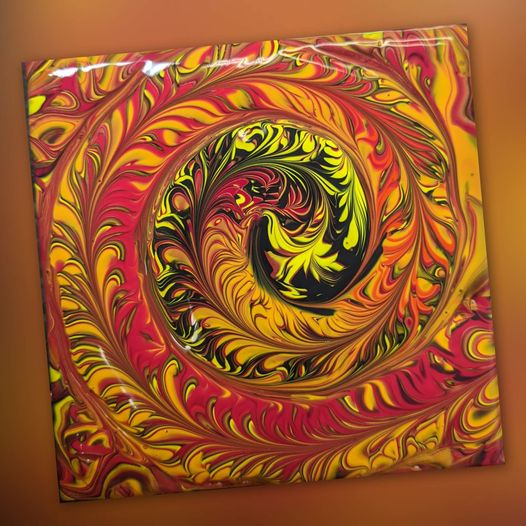
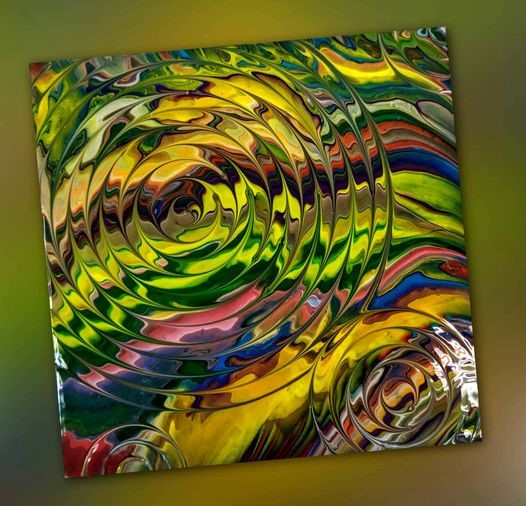
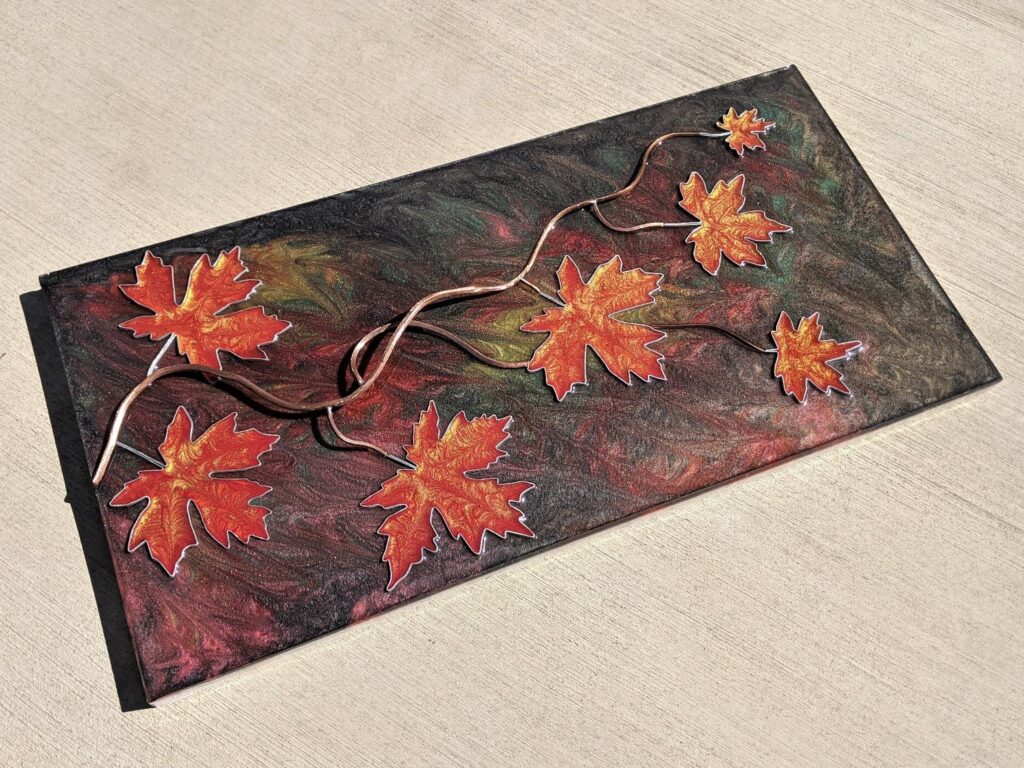
Thanks so much Jonny for sharing your secrets here! You’ve inspired us all.


Thanks for sharing. I read many of your blog posts, cool, your blog is very good.